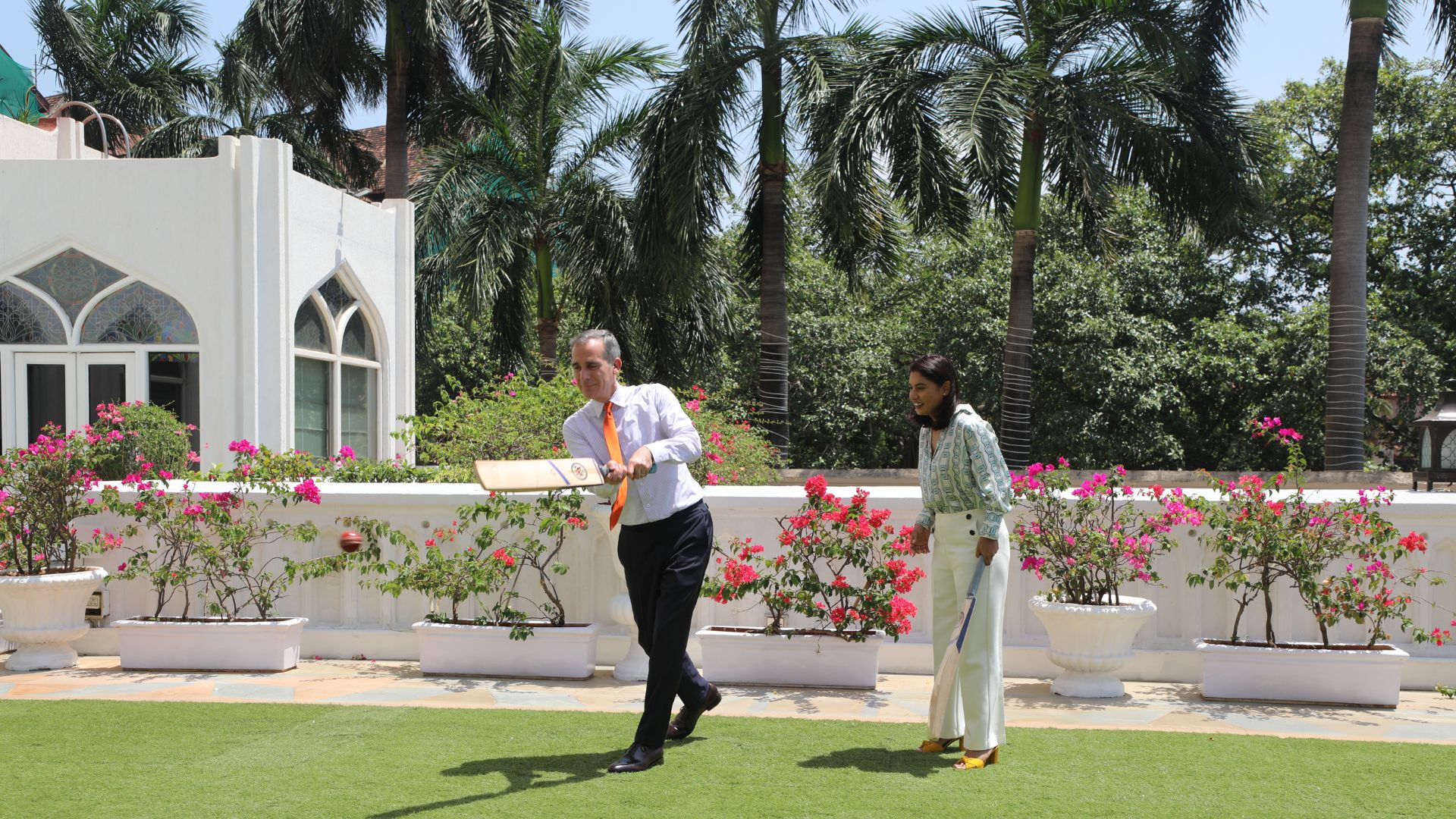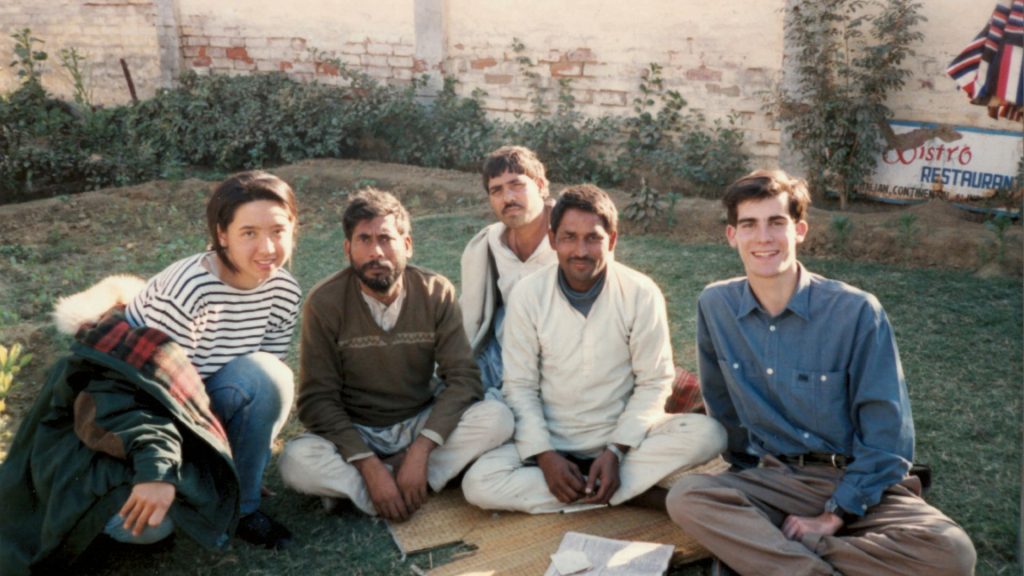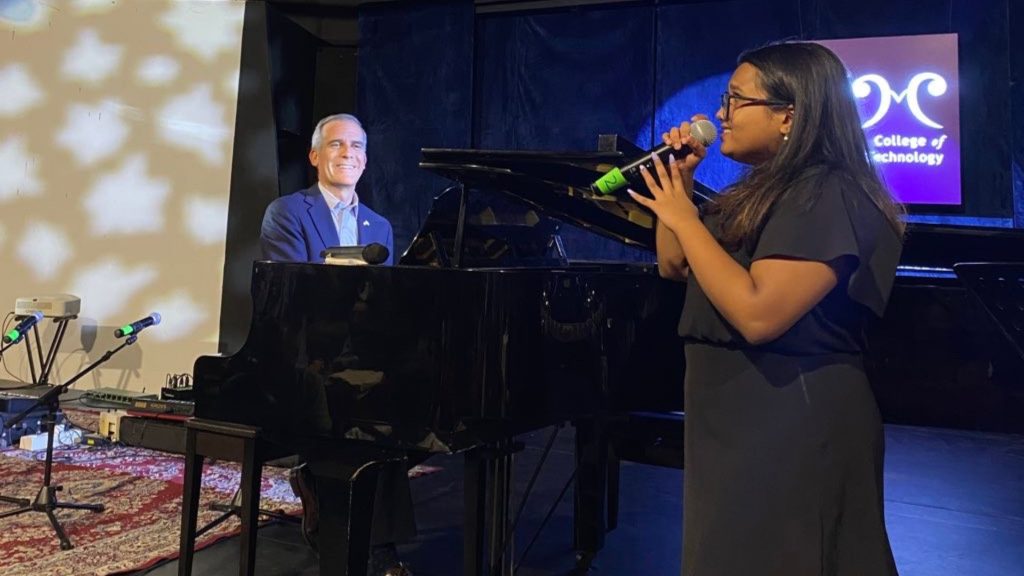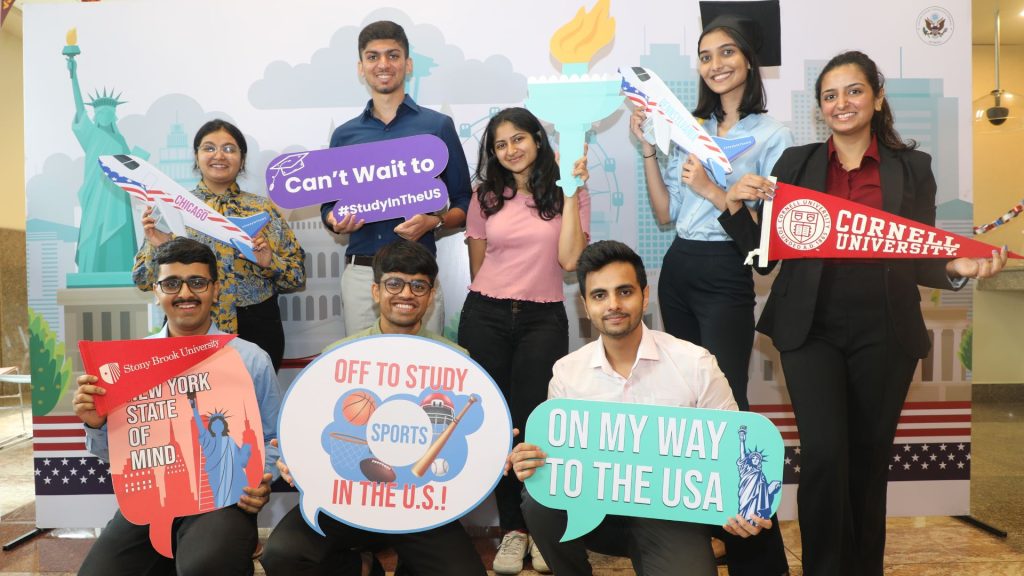U.S. Ambassador to India Eric Garcetti on what excites him the most about the U.S.-India relationship.
July 2023

Ambassador Eric Garcetti tries his hand at cricket with Indian cricketer Mithali Raj in Mumbai. (Photograph courtesy U.S. Consulate General Mumbai)
Ambassador Eric Garcetti serves as the 26th U.S. Ambassador to India. He is a committed public servant, educator and diplomat. After serving on the Los Angeles City Council for 12 years, Ambassador Garcetti won election in 2013 as the youngest mayor in the city’s history. He then won reelection in 2017. As Mayor, he oversaw a period of economic growth and opportunity, won a bid for Los Angeles to host the Olympic and Paralympic Games in 2028, and pursued an aggressive health and climate agenda. Ambassador Garcetti served as a naval officer in the reserve component for 12 years.
Ambassador Garcetti earned a B.A. as a John Jay Scholar from Columbia University, where he studied Hindi and Indian culture. He holds a Master’s degree from Columbia University’s School of International and Public Affairs, and he was a Rhodes Scholar at The Queen’s College, Oxford. He is married to Amy Elaine Wakeland, a fellow member of his Rhodes Scholar class. They have one daughter and have been foster parents for more than a decade. A fourth-generation native of Los Angeles, Ambassador Garcetti is a proud card-carrying member of the Screen Actors Guild and is an avid pianist and photographer.
Excerpts from an interview with SPAN.
Please tell us about the time you spent in India as a young man.
I first came to India as a 14-year-old in 1985 with my sister, my mother and father. And it was a revelation—a place that immediately captured my heart and reminded me that India and the United States have a long history. Look at the way India has influenced the United States and vice versa, the way Gandhi inspired Martin Luther King, the way that we have fought for our freedoms and for our countries to be great.
I returned in 1990 and many times after, each time the years telling me things the days couldn’t see. I’ve been able to see the incredible trajectory and the ways in which the things I love about India—its amazing people, its warmth, its history and culture—have not changed but the ways in which economic prosperity and India’s place in the world have changed and continue to grow from strength to strength. I still feel like that 14-year-old boy here in India with a sense of wonder but also now, as Ambassador, having a chance to write a chapter together with Indians and Americans for the future.

Ambassador Garcetti (right) visited India as a young man in the 1990’s. (Photograph courtesy Ambassador Garcetti)
As a pianist, which musicians inspire you?
I come from a family of musicians. My grandparents met when they were both in music school during the Great Depression. My mother played jazz and classical piano and taught me to play too. As a kid, I played jazz. I was a composer in college, of musicals and other things. I love all types of music.
I enjoy many strains of Indian music, from great composers like A.R. Rahman who have written soundtracks in Hollywood, sitarists like Ravi Shankar and great pianists like Vijay Iyer. Jazz is my favorite of all genres. Keith Jarrett is my number one influence, but I love sitting down at a piano without an idea of a song in my head and just improvising. Having a chance to let the universe speak through your hands and your soul.

Ambassador Garcetti in a jam session at KM Music Conservatory in Chennai. (Photograph courtesy U.S. Consulate General Chennai)
How do you think cultural diplomacy can strengthen U.S.-India ties?
Cultural diplomacy is something Americans and Indians do every day without even knowing it. We watch a YouTube video, or “Naatu Naatu” wins an Academy Award, or see Diljit Dosanjh come to the Coachella festival with music from India—we are engaging in cultural diplomacy. But I think we can go further. I believe that when you touch people’s hearts through stories, music or sports, it has the power for us to recognize that we are all part of the same human family. And specifically, I really want to continue to bring and build these bridges from Hollywood to Bollywood and to the wider Indian film industry here, and bring more Indian cinema to the United States.
Sports is another aspect of culture, for us to bring our sports like basketball and even American football here while we learn about cricket and see the ways that they can enrich our lives. Cultural diplomacy unites us. It will be a core part of the work that I do here as Ambassador.
What are your favorite Indian foods? What do you look forward to trying during your travels in India?
I love Indian food. I have eaten it my entire life and cooked it at home in the United States. It is difficult to pick a favorite but a good idli is a great way to start the day. I also like chole masala or Kolkata biryani—I love all regional food.
If I had to pick one thing, it might be a good thali that you just can have over and over. I love eating with my hands. I think for a lot of Americans, that’s a new thing. But I’m half Mexican, so we eat with tortillas. That’s the way you experience food with your fingers.
I love spicy food, anything with chilies. In restaurants, they don’t believe me; they think Americans can’t take it, but I can.
If you could tell an American student one thing about India and an Indian student one thing about America, what would you say?
I would say that the United States and India, together, have the ability to change the future of the world. These are two great countries. One with a deep civilizational past, one which is the oldest democracy. One that’s now not just the largest democracy, but the most populous country in the world. Both places are diverse, complicated, but in some ways flipsides of the same coin.
We are many countries in one, and we have much to learn from each other, but at the core we have parallel values. The idea that everybody belongs, that everybody should count, no matter where they come from, what language they speak, whom they love, how they worship. These things, to me, are keystones that have defined India and America over the years. I would also say to American students, come visit. We need more American students in India. We have great study abroad and educational exchange programs like the Critical Language Scholarship and the Fulbright-Nehru Scholarship programs that support American students to come study in India.
One of my goals is to bring more Americans to India. Just as I came here when I was a student, other Americans need to come here, to know India, to speak its languages, to learn about its history and its culture. I tell American students, regardless of your interests, be they business, politics, culture, or music, India will enrich your life and help you do better.
To Indian students, I would say we love Indian students coming to the United States. We processed a record number of student visas from India to the United States. We want Indian students to come to the United States and see some of the great work that both countries are doing on technology and STEM, but also in other areas. I would tell Indian students that we want you to come and study. We want you to come and contribute. We want you to come and take some of America back home with you.
That is what will really strengthen this relationship. Not an ambassador with a prime minister, not a president with a foreign minister. It will be everyday people who know and love both countries.

The U.S. Mission in India held its seventh annual Student Visa Day, which celebrates the long-standing higher education ties between the United States and India, in June 2023. (Photograph courtesy U.S. Consulate General Mumbai)
How can young people in the United States and India contribute to this exciting time for the partnership?
The number of Indians who are 16 years old or younger equal the entire population of the United States of America. It is very exciting to be in a country where youth can change not only the direction of this country, but can influence our country and the entire world.
I would say, be bold, be friendly, lead with your heart. Bring your culture and your ideas. Be creators. I love Indian hip-hop, Indian jazz, and American musicians building on Indian musical traditions and fusing those things together.
I think for a young person today, we don’t see borders. We don’t see that we only fit into one thing, one place, one style. I can’t wait to see what the U.S.-India mashup becomes, guided by young people who have ideas of where fashion should go, what the next big hit will be, about the next story to tell, or how technology can change our lives, improve our health, and increase our prosperity.
Finally, I’d say to young people, bring your values. We all want a world with gender equity, where everybody belongs, a world in which there is no poverty, where we can breathe the air, where we have confronted the climate crisis. Bring your passion and your solutions to the challenges we face. India can’t face those alone and America can’t face those alone. But together we are better.
What’s your message to SPAN readers?
I always say this—be fearless. Don’t let anybody tell you that you can’t do something. You can. Second, be humble. Don’t let fearlessness make you arrogant. Third, I would say, learn to listen. It’s one of the most important qualities you can have. We’re all taught to do what I’m doing right now, learn how to speak better, give speeches, put out our social media. But if you listen to the world, you will speak with so much power. The last thing is, always lead with love. If you lead with love, you’ll find the good in everybody. You will put out in the world a better tomorrow. And together we will build a better world.
Click here to sign up for the free SPAN newsletter: https://bit.ly/SubscribeSPAN
COMMENTS